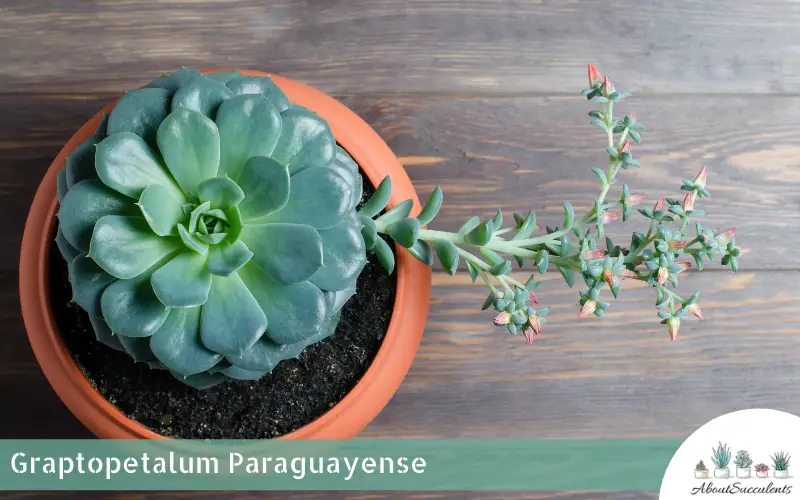
Graptolpetalum paraguayense is an elegant yet, thought-provoking succulent. When you see the succulent, you’ll wonder if it’s a real plant.
Graptolpetalum paraguayense’s pinkish-grayish pale-colored, opalescent leaves give it a surreal appearance which is why it is sometimes called “Ghost Plant”. Another popular name is “Mother of Pearl”.
Ghost Plant forms clumps and grows a rosette of fleshy leaves that resemble those of the Echeveria variety. The thick leaves have a special purpose. They can store water so that the plant can survive long periods of drought.
In hot and dry climes, the succulent’s colors turn pinkish-yellow but under shaded conditions, the plant assumes a bluish-grey color.
Graptolpetalum paraguayense can grow to a height of 12-inches (30cm) while the rosettes can expand to a width of 4-inches (10cm). It is part of the Crassulaceae family. Initially thought of as coming from Paraguay because of its name, Ghost Plant is native to East Central, Mexico.
General Information:
Also known as: Ghost Plant, Mother of Pearl
Plant Family: Crassulaceae
Origin: East Central Mexico
Height: 12-inches (30cm)
Exposure: Full to partial sunlight up to 6 hours per day
Water Needs: Light watering schedule during the summer months; very little to no watering in the winter or cold season.
Soil Type: Cactus soil or soil mix made of potting soil with equal parts loam and gravel such as pumice or lava grit.
Soil pH: Acidic (6.1 to 7.8 pH)
Tolerance: Drought
How To Grow And Care For Graptolpetalum Paraguayense
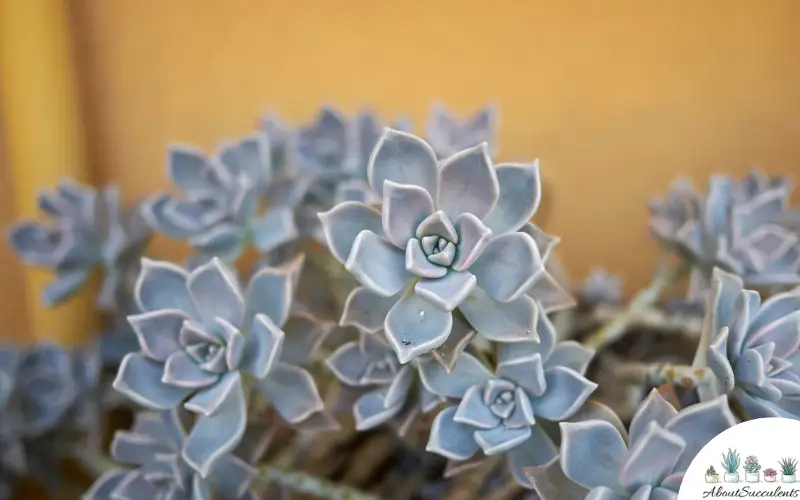
Graptolpetalum paraguayense is an attractive succulent that is best grown outdoors to allow the plant to achieve its “ghostly” appearance.
Ghost Plant grows rapidly and can trail up to 3-feet (91cm) of space which is why it is popularly used as ground cover.
This succulent has been known to survive freezing temperatures but nevertheless is not cold-hardy. Ghost Plant is best suited in Zone 9a temperatures or a minimum of 20° F (-6° C).
If you reside in a region that drops below 20° F (-6° C), it would be best to grow the plant indoors. Keep in mind that this fast-growing plant grows even faster indoors.
1. Sunlight
Graptopetalum paraguayense enjoys the sun and thrives in full to partial exposure. This succulent has chameleon-like properties and will adapt to the environment’s conditions.
There are varieties that have grown well in areas with partial shade. The differentiating factor is the color: Ghost Plant in shaded areas develops bluish-gray color.
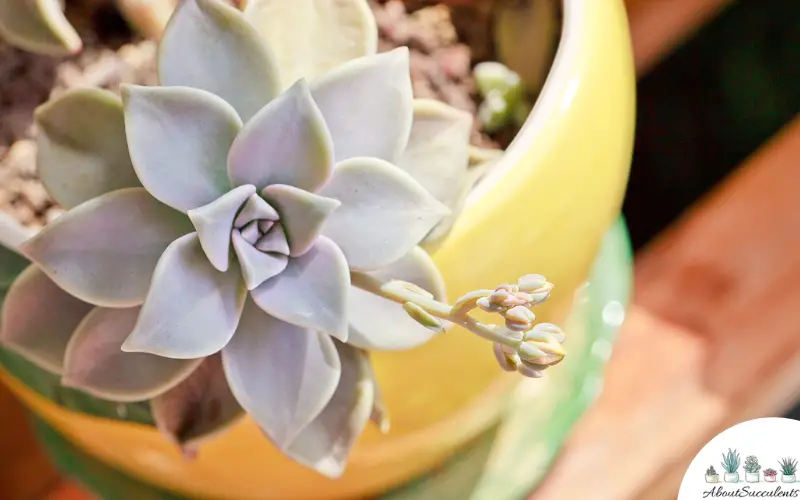
If grown outdoors, plant Graptopetalum paraguayense in an area in the garden which gets 6 hours of morning sunlight.
Ghost Plant that will be grown indoors should be placed near a window that receives full to partial sun.
2. Watering
Graptopetalum paraguayense exhibits similar watering needs of a succulent that comes from the Crassulaceae family. It will require more water in the summer season and less during the winter periods of October to March.
Before giving Ghost Plant water, make sure the soil is dry to the touch. Typical of succulents, Graptopetalum paraguayense will suffer from root rot if given too much water.
3. Pot and Soil
When choosing a pot, get one that offers good drainage. Graptopetalum paraguayense has shallow roots which means it will not require constant repotting. Once the succulent has outgrown its pot, transfer it carefully by grasping at the base of the crown and not by its leaves.
You can use a light potting or cactus mix for its soil. The important thing is that the soil should be gritty, porous, and has good drainage. You can prepare a soil mix made of potting soil with equal parts loam and gravel such as pumice or lava grit.
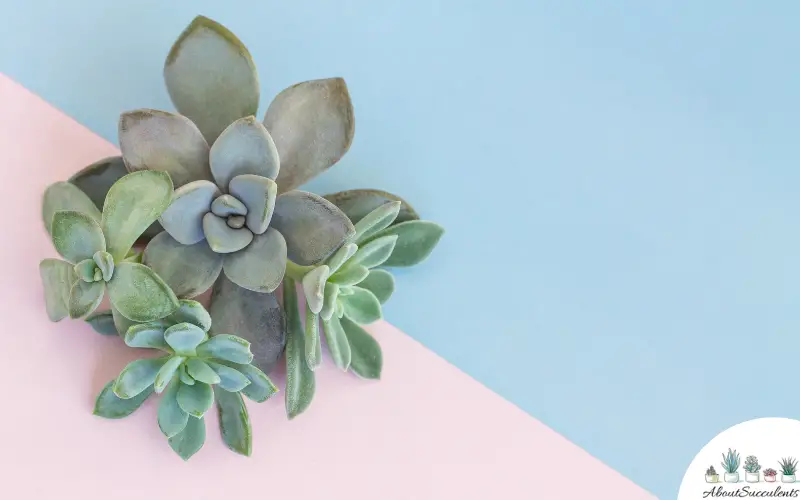
Feed Ghost Plant with a commercial fertilizer that is manufactured for succulents and dilute it to ¼ of its strength by adding water. Fertilizer should only be given once a month during the spring months.
How To Propagate Graptopetalum Paraguayense
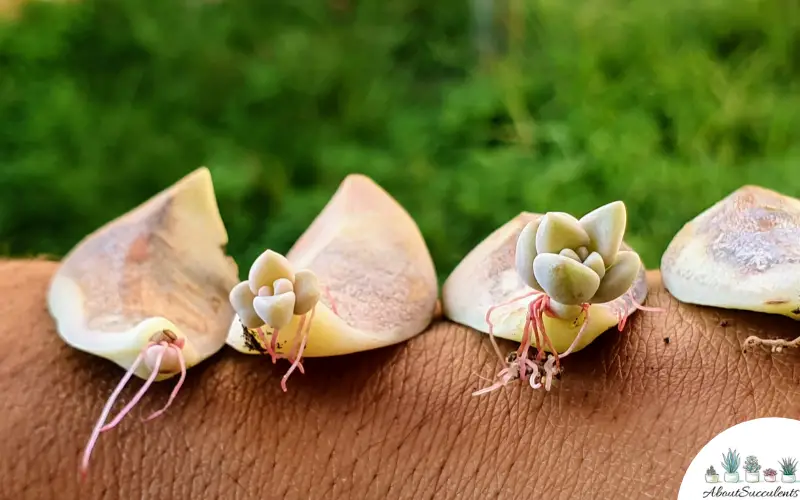
If you want to have more Ghost Plant in your garden, the good news is that this succulent is easily propagated through its leaves or cuttings.
A third method is through the use of seeds but this will be a much longer process compared to leaves or cuttings.
1. Leaves Method
Step 1 – Gently remove a leaf by twisting if off from the mother plant. Removing the leaf should be done cleanly. If there are parts of the leaf left on the stem, your chances of propagating the plant successfully will be much less.
Step 2 – Place the leaf in a dry and shaded area for several days until it hardens or develops calluses.
Step 3 – Once calluses are present on the leaf, plant it on well-draining soil.
2. Cuttings Method
Step 1 – Use a sharpened and sterilized pair of garden shears or scissors to cut a piece of the plant just above a leaf on its stem.
Step 2 – Allow the cuttings to develop calluses.
Step 3 – Plant the cuttings on well-draining soil.
3. Seeds Method
Step 1 – You can buy commercially available seeds or collect the seed pods that form after the leaves have withered.
Step 2 – Plant the seeds in a sterilized potting soil mix.
Step 3 – Use a mister to water the seeds to keep them from getting displaced.
Step 4 – Place the seed tray under bright light with a temperature of 70° F (21° C). Germination should take place in 3 weeks.
Frequently Asked Questions
Is Graptopetalum Paraguayense Toxic for Cats and Dogs?
Graptopetalum paraguayense does not appear in the list of plants that are toxic to cats and dogs on the website of the American Society for the Prevention of Cruelty to Animals (ASPCA).
Why is my Graptopetalum Paraguayense Succulent Dying?
There are 2 possible threats to the safety of your Graptopetalum paraguayense: Overwatering and Pest Infestation.
1. Overwatering
Graptopetalum paraguayense’s leaves have the ability to store water and keep it hydrated during extended periods of drought. It will not thrive if given excessive amounts of water especially during the winter season when the soil stays moist longer.
Overwatering or having its roots submerged in water for a long time will lead to root rot. When the roots start to rot, the level of deterioration can reach to other parts of the plant rapidly. You will notice rotting if you see sections of Ghost Plant turning into a brownish or blackish color.
If you see evidence of rotting, remove the deteriorated section right away with a sanitized pair of scissors or knife. Remove the plant gently from the soil and check for more signs of deterioration. Cut out the rotted portions of the roots. Allow the plant to dry before re-planting in a pot with new potting soil.
2. Pest Infestation
Graptopetalum paraguayense experiences some of its leaves falling off and dying. Remove the dead leaves that have accumulated near the plant.
Dead leaves become a home for mealybugs and other pests. Mealybugs leave white, cotton-like substances on the leaves of Ghost Plant. Remove these substances with a ball of cotton that has been immersed in denatured alcohol.
Does Graptopetalum Paraguayense Produce Flowers?
Yes, Graptopetalum paraguayense produces flowers that are star-shaped, colored white with red specks. The flowers are small; only 0.78-inches (2cm) and bloom in the springtime.
Last Updated on June 10, 2022 by Sofia Lara